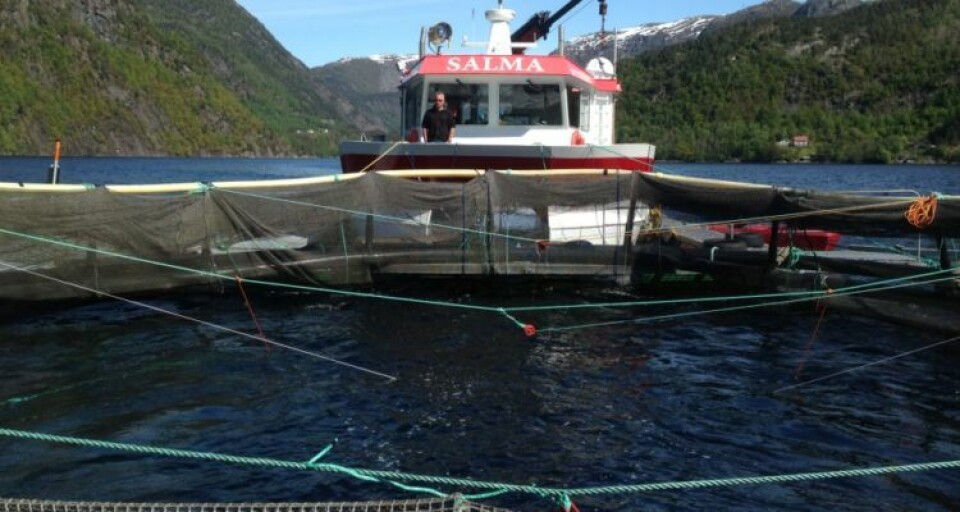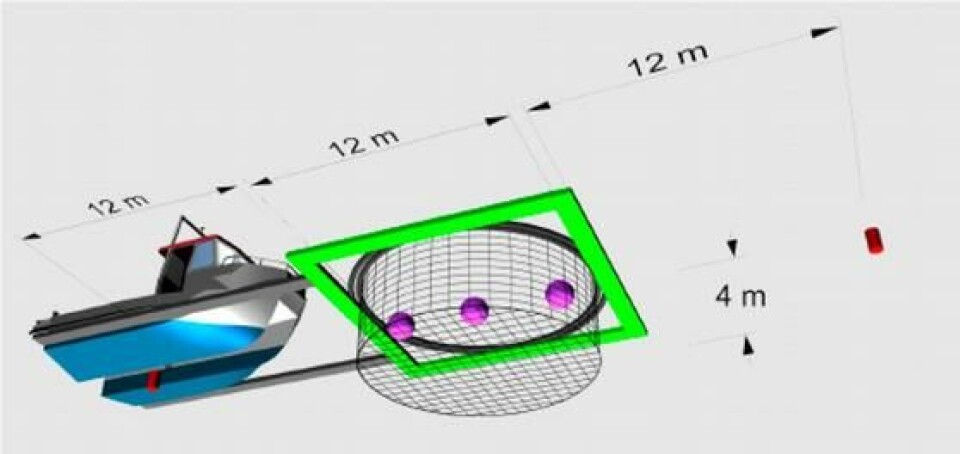
‘Push-cage’ tests salmon readiness for wilder water
Researchers have developed a cage pushed by a boat to recreate strong currents and test how salmon fare in high-energy conditions.
New technology means exposed areas with a lot of waves and strong currents are becoming increasingly relevant for new farms. But it's not just the cages that must withstand the forces of waves and water currents. The salmon have to, also.
It is known from previous experiments that farmed salmon in cages change their behaviour according to the current. Under demanding conditions, the salmon shoal forms a "wall" of fish against the current.

"Just as a cyclist takes advantage of being in a large group in order to maintain a high speed, the salmon change group behaviour when the flow rate is high," explained project manager and researcher Frode Oppedal, of Norway's Institute of Marine Research, on the IMR website. "Farmed salmon normally swim round and round in a shoal in the cage, but this behaviour changes ie when the current is strong."
"For the tests be relevant to the aquaculture industry, we need to understand the behaviour of large groups of fish," added Oppedal.
Recreating a strong current
He came up with the idea of a "push cage" that can be pushed forward by a boat, allowing the cage speed can be accurately controlled. That way the researchers can also recreate conditions of a strong water current.
"This way we can find the fish's tolerance for current when it swims in shoals, ie in a real farming environment," said Ole Folkedal, an IMR researcher.
Folkedal said that with such a solution they can measure the critical swimming speed. That is, the limit for when the first salmon get exhausted over a short period of time in a few minutes, then at a steadily increasing speed.
Critical swimming speed
The push-cage method is based on an established research standard, where the critical swimming speed is measured in swimming tunnels, explained Folkedal.
Fish neither die nor are injured by pushing the cage. When salmon are exhausted, they gather in the back of the cage. Then, the researchers lower the speed of the boat so that the fish can recover. In an aquaculture cage the fish do not have this opportunity to recover. In the worst case, the fish that can withstand the least die.
To measure the critical swimming speed scientists took groups of 1,500 salmon at three to four kilograms on tour in Masfjorden in a sliding cage.
Against the tide
"We saw that the salmon shift from a circular shoal structure to stand against the tide at the same current as we have previously observed in exposed fish farming in the Faroe Islands," said Oppedal.
But the fish kept out in a stronger current than scientists expected.
"Two per cent of the fish were exhausted when the flow rate was 1.25 metres per second, which is a higher rate than what we expected from the results in swimming tunnel experiments."
Oppedal and colleagues have recently published the results of the experiment in the journal Aquaculture.
Surprisingly good capacity
Individual swimming performance varies within groups of fish, and in fish farming the critical limit of fish with the worst swimming performance must be taken into account. It varies, depending upon how persevering individual fish are. Farmers must therefore adapt to the fish with the poorest swimming capacity.
This was allowed for by the researchers conducting the push-cage experiment. It turned out that even the weakest subjects showed a surprisingly good swimming capacity in the sliding cage.
"Based on the results, it seems as if the salmon are changing their behaviour in strong currents, making them more adapted to cope with the most extreme periods. We also see that there is a clear upper limit on the current, which should not be exceeded," said Oppedal.























































